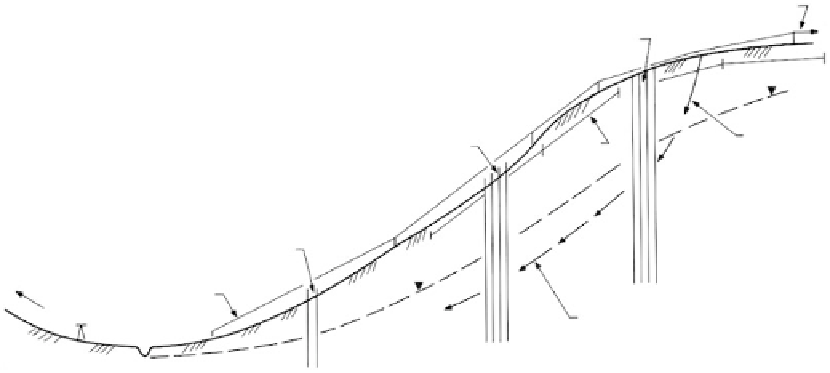Environmental Engineering Reference
In-Depth Information
monitor the rate of movement and accelerations, locate the failure surface, and monitor
pore pressures. These data provide the basis for anticipation of total and perhaps sud-
den failure.
Slope Stability Problems
In potentially unstable natural or cut slopes, failure is usually preceded by the develop-
ment of high pore-water pressures, an increase in the rate of slope movement, and the
occurrence of tension cracks. Slope movement is not necessarily indicative of total failure,
however, since movements are often progressive, continuing for many years. Stability
evaluations require information on the failure surface location, pore pressures, and rates
of movement as well as the geologic and climatic factors
(Chapter 9).
Instrumentation
Surface movements of the natural slope shown in
Figure 4.42
are monitored by precise
leveling with the laser geodimeter (a), convergence meters (g), and strain meters (h). The
meters may be attached to alarm systems. GPS will find these meter to be increasingly use-
ful for long-term monitoring.
Subsurface deformations are monitored with the inclinometer (L), shear-strip indicator
(n), or steel-wire sensor to locate the failure surface. Acoustical emissions (q) may indicate
approaching failure.
Pore-water pressures are monitored with piezometers (r). One can estimate the pore
pressures required for total failure by knowing the failure surface location and soil shear
strength.
Installations
Piezometers, inclinometers, extensometers, and other devices used in boreholes may not
monitor the most critical areas, especially in slopes in a stable condition. Therefore, opti-
cal surveys, which provide information over the entire study area, are always important,
although, because of terrain conditions, perhaps not always possible.
(g)
(L, n, q, r)
Tension
crack
(L, n, q, r)
(h)
(q, r)
(g)
(a)
Potential
failure
surface
FIGURE 4.42
Instrumentation for a potentially unstable soil slope. Legend: (a) precise surveying; (g) convergence meter; (h)
strain meter; (L) inclinometer; (n) shear-strip indicator; (q) acoustical emissions device; (r) piezometer.



